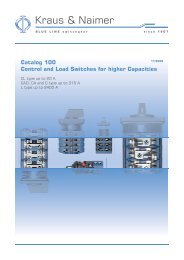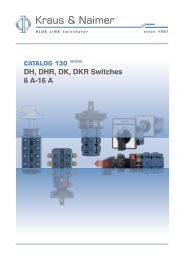Create successful ePaper yourself
Turn your PDF publications into a flip-book with our unique Google optimized e-Paper software.
<strong>Vacuum</strong> Interrupter<br />
Operating characteristics<br />
50<br />
Figure 2. Current flow and driving force<br />
on arc for spiral contact<br />
Fault<br />
current<br />
(ⅰ) Weld<br />
(ⅱ) Bridge explosion<br />
Arc initiation<br />
Current path<br />
Driving force on<br />
the high current<br />
ARC<br />
ARC<br />
(ⅰ) Contact jets<br />
(ⅱ) Shield involvement<br />
High current arc mode<br />
Figure 3. AC arcing and interruption phenomena in vacuum.<br />
In the closed position, normal current flows through<br />
the interrupter. When a fault occurs and interruption<br />
is required, the contacts are quickly separated.<br />
The arc drawn between the surfaces of contacts is<br />
rapidly moved around the slotted contact surface<br />
by self induced magnetic effects, preventing gross<br />
contact erosion and the formation of hot spot on<br />
the surface.<br />
The arc burns in an ionized metal vapor, which<br />
condenses on the surrounding metal shield. At<br />
current zero the arc extinguishes and vapor<br />
production ceases.<br />
The metal vapor plasma is very rapidly dispersed,<br />
cooled, recombined, and deionized, and the metal<br />
vapor products are quickly condensed so that the<br />
contacts withstand the transient recovery voltage.<br />
(ⅰ) Arc instability<br />
(ⅱ) Interruption<br />
Current<br />
zero<br />
Time (ms) Time (㎲)<br />
Recovery<br />
voltage<br />
Voltage Phenomena<br />
(ⅰ) Arc reignition<br />
(ⅱ) Restrikes<br />
(ⅲ) B. I. L<br />
(ⅳ) AC voltage<br />
withstand





